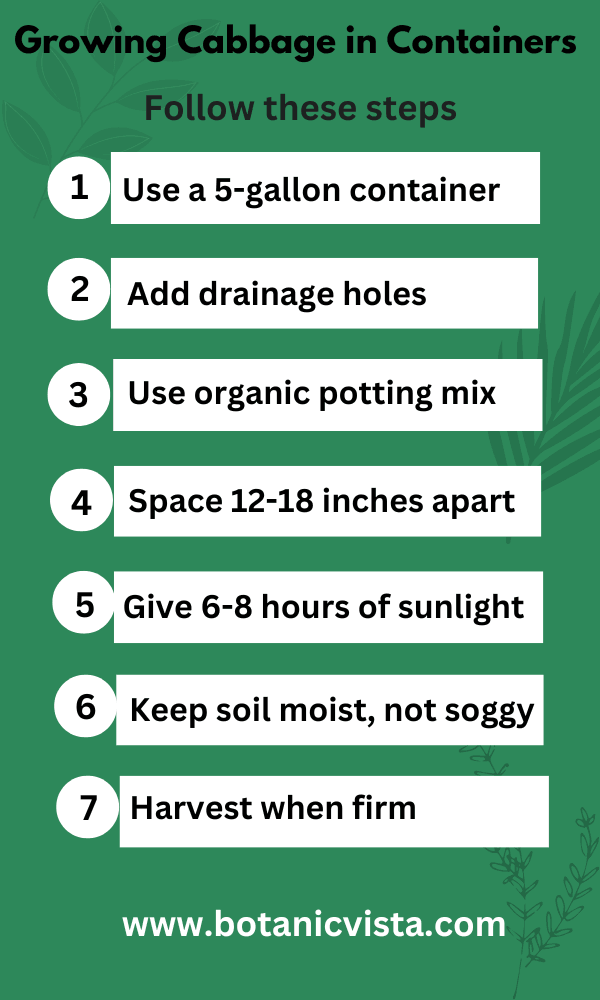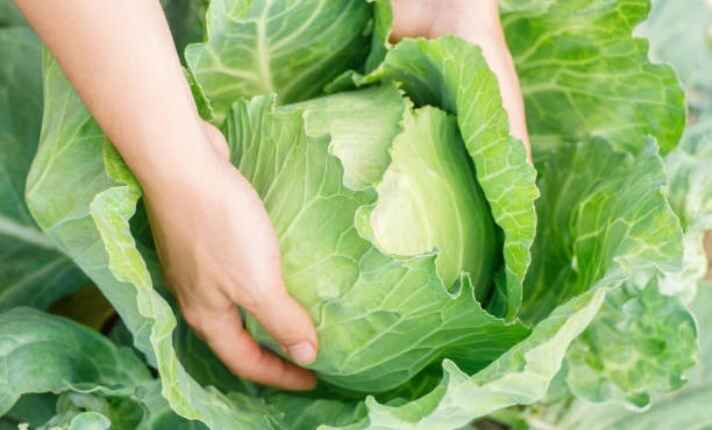Last Updated on October 10, 2024 by Jocelyn
Planting cabbage in containers is an easy way to grow your own vegetables. You can enjoy fresh cabbage all year round with just a little space.
First, choose a sunny spot for your container. Cabbage loves sunlight. Make sure to use nutrient-rich soil to keep your plants healthy. Brassica oleracea, which includes cabbage, broccoli, and cauliflower, needs good soil to avoid nutrient deficiencies.
Cabbage is a biennial plant often grown as an annual. It has dense-leaved heads in green, purple, and pale green. You can try different cultivars like Savoy, known for its crinkle-leafed texture, or firm-headed varieties.
Plant cabbage seeds in separate containers to avoid cross-pollination and pests. Regularly check for bacterial and fungal issues to keep your plants healthy. Growing cabbage in containers helps control these problems better.
With enough space, your cabbage can grow well. This plant can weigh between 500 to 1,000 grams. With the right care, you can savor the taste of homegrown cabbage and add a fresh touch to your meals.

Table of Contents
ToggleWhy Choose Container Gardening for Cabbage?
Growing cabbages in containers is perfect for urban gardeners. It helps manage pests and prevents cross-contamination with other plants. Containers make watering and harvesting simpler.
It uses less space and can be done year-round. With the right care, it’s easier to avoid pests like the cabbage root fly. Balanced pH levels in the potting soil ensure healthy plants.
| Aspect | Benefit |
| Accessibility | Easier to manage and harvest cabbages. |
| Pest Control | Reduces risk of common pests. |
| Space Efficiency | Ideal for small areas like balconies. |
| Nutrient Management | Better control over soil nutrients. |
| Year-Round Growing | Grow cabbages in various environments. |
Selecting the Perfect Container
Container gardening allows you to control the growing conditions more effectively, ensuring a healthy harvest. Here are the key aspects of choosing the perfect container for your cabbage plants.
Ideal Size
Choose a container that is at least 12 inches deep. This allows the roots to grow properly. A 5-gallon pot works well. The size is important for the growth of your cabbage. Cabbage plants can reach a height of 18 to 24 inches, so adequate depth is essential.
Best Materials
Clay and ceramic containers are good choices. They provide natural breathability. Plastic pots are lightweight and durable. Raised beds can be used too. Many gardeners prefer plastic due to its durability and cost-effectiveness.
Proper Drainage
Ensure your container has holes at the bottom. This prevents the soil from getting waterlogged. Proper drainage helps avoid root rot. Containers with good drainage are essential for healthy plant growth.
Shape Considerations
Rectangular containers can be better than round ones. They offer more space for the roots. Rectangular shapes also fit well in small spaces. Rectangular pots can increase root space, promoting healthier growth.
Color and Heat
Dark colored pots absorb more heat. This can be good in cold climates. However, in hot climates, choose light colored containers to keep the soil cool. Color can affect the temperature of the soil. Light-colored containers can keep soil temperatures 9 to 18ºF cooler.
How to Grow Cabbage in Containers from Seed
With just a little effort, you can have crisp, delicious cabbage right at your fingertips, perfect for salads, soups, and more. Enjoy the convenience and satisfaction of growing your own vegetables, even in a small space!
Let’s explore how to easily grow fresh cabbage in containers.
1. Choosing Seeds
Select cabbage seeds based on your preferred head type. Options include pointed, rounded, and loose heads. Compact varieties are ideal for small plots and containers.
2. Preparing Seeds
Soak your cabbage seeds for a few hours to speed up the germination process. This helps the embryo inside the seed to sprout faster.
3. Ideal Soil Mix
Prepare a well-draining potting soil mix enriched with organic matter and compost for added nutrients. Ensure the pH levels are between 6.5 to 7.5 for optimal growth.
4. Planting Depth and Spacing
Plant the seeds at a depth of 1/4 to 1/2 inch. Cover them lightly with soil and pat down gently. Keep the soil consistently moist but not waterlogged.
5. Germination Conditions
Place the containers in a sunny site with temperatures around 60 degrees F (15 C). Use a spray bottle for watering to keep the soil moist. Seeds should germinate in about two weeks.
6. Transplanting Seedlings
When the seedlings are about 3-4 inches tall and have developed two sets of true leaves, they are ready to be moved. Transplant them to a larger final container, such as a 5-gallon (19 L) pot, ensuring proper spacing to avoid crowding.
Find out more about vegetable gardening with my expert guides:
- Growing Green Beans in Containers
- How to Grow Lettuce in a Pot
- Growing Radishes in Pots
- How to Grow Kale in Containers
Caring Tips for Cabbages in Containers
Caring for cabbages in containers involves a few simple steps. Follow these tips to ensure your container-grown vegetables grow successfully.
- Watering
Ensure consistent moisture by using a watering can or hose attachment. Avoid waterlogging to prevent root rot and fungal diseases. Water deeply but less frequently to encourage strong root growth.
- Mulching
Add organic mulch at the base of your plants. This helps regulate temperature, keep the soil moist, and control weeds. Mulch also provides additional nutrients as it breaks down.
- Feeding
Cabbages are heavy feeders. Use balanced fertilizer and compost tea to provide necessary nutrients. Apply a slow-release fertilizer to ensure a steady supply of nutrients throughout the growing season.
- Sunlight
Cabbages love full sun. If you don’t have enough direct sunlight, use grow lights. Provide some shade if the weather gets too hot to prevent premature flowering.
- Soil Maintenance
Use fresh soil to give your cabbages the best start. Mix in manure or garden compost to enrich the soil. Avoid waterlogging to prevent root rot and fungal diseases.
- Pest Protection
Use fine-mesh netting to protect from cabbage worms, cutworms, and other common pests. Regularly check for eggs and pests. Maintain good air circulation to reduce the risk of fungal leaf spots and other diseases.
- Spacing and Thinning
Avoid overcrowding by properly spacing your cabbages. Thin seedlings to ensure each plant has enough room to grow. This helps prevent competition for nutrients and reduces the risk of pests.
- Monitoring Growth
Regularly inspect leaves for signs of yellowing or nutrient deficiency. Remove outer leaves if needed. Watch for proper head formation and ensure your cabbages grow firm and healthy.
Cabbage Harvesting
When cabbage is ready for harvesting, use a knife to cut the head from the stem. This should be done through the outer leaves. Depending on the maturity of the cabbage, the head will be firm and dense. Standing cabbages should be checked every few weeks to score maturity.
Once the head is cut, you can let the stump stay in the ground. This is a good idea because it can produce a second head. Throughout the spring and summer, this method can provide a continuous supply.
If the second head is mature, you can cut it too. The stumps should be left standing as they can eventually produce more heads. This way, you can grow larger cabbages in your kitchen garden without digging up the entire plant.
By scoring the stump at levels, you help the plant grow better. Initially, the firm head will be small, but eventually, it will mature. The cabbages will be ready in a few weeks depending on the weather.
Using this method through the spring and summer will ensure a good harvest. They will be firm and tough, ready for your kitchen.
I’ve tried this method and it works well. My cabbages were firm and dense, perfect for salads and cooking.

Adapting Techniques for Different Regions
Cabbage container planting requires specific techniques for different regions. Adjust your methods based on the local climate to ensure healthy growth. Use heat-resistant varieties in hot areas, and choose frost-hardy types for colder regions. Proper shading, watering, and soil management are key to successful development.
| Region | Tips |
| Tropical | Start seeds indoors, use heat-resistant varieties, provide shade, and mulch to keep soil cool. |
| Temperate | Plant in spring or late summer, use row covers, and mulch to retain moisture. |
| Cold | Choose frost-hardy varieties, start seeds indoors, and use cloches and cold frames. |
| Arid | Plant in early winter or late autumn, shade the plants, and keep soil moist with watering and mulching. |
| California | Plant in fall or spring, amend potting mix with compost, and inspect regularly for pests like aphids and cabbage loopers. |
FAQ’s
Q: Does Cabbage Grow Well in Pots?
A: Yes, cabbage grows perfectly in pots. Use a rectangular planter at least 10 inches deep and 18 inches wide, spacing cabbages 6 inches apart. Growing them is easy and possible in small spaces.
Q: What Does Cabbage Not Grow Well With?
A: Cabbage does not grow well with tomatoes, beans, peppers, and strawberries. These plants compete for the same nutrients, which makes it hard for cabbage to grow.
Keep cabbage away from other brassica family members like broccoli, kale, and cauliflower. This helps prevent diseases from spreading.
Q: How Long Does Cabbage Take to Grow?
A: Growing cabbages in containers is easy. It generally takes about four to six months to reach maturity. Depending on the type and variety of cabbages, they can grow in spring, summer, autumn, or winter. Sowings can be done at any time of the year.
Q: What Is the Best Soil for Cabbage in Pots?
A: Use a quality potting mix with rich compost. Ensure the soil has good fertility and is well-draining. Add organic matter to supply the necessary nutrients for the cabbage.
Q: How Do You Prepare Soil for Cabbage?
A: First, dig a hole in the planting bed. Add compost and organic materials to the soil. This helps the cabbages grow better.
Remove any debris and decaying plants from the soil. This keeps the area clean for the cabbages. Spread mulch on top to keep the soil moist.
Conclusion
Growing cabbage in containers is useful for those with limited space. Pick a deep container with good drainage. Plant seeds in rich soil and keep it moist. Give your cabbage plenty of sunlight and water it regularly. Keep an eye out for pests and diseases, and use organic methods to protect your plants. When the cabbage head feels firm, it’s time to harvest. By following these steps, you’ll enjoy a healthy cabbage harvest at home.

